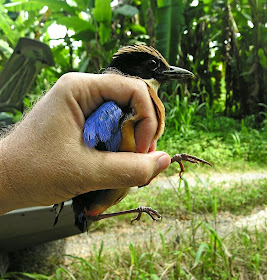
The strategy was simple enough - head for the nearest limestone karst and look for an access road that would take us as near to the base as we could get.
At the first one we tried, we hit the jackpot almost as soon as we got out of the car - two Blue Whistling Thrushes flying away from the cliff face above treetop height. I waited around the car, while Eileen, our eager assistant for this trip, walked off to try to get a GPS reading.

I was rewarded after 10 minutes by a whistling thrush landing in a tree not far away with a beak full of worms, clearly on its way to feed nestlings. It wasn't that obviously different from 'dicrorhynchus' birds we have seen further south, though the white tips to the median coverts looked whiter and more distinct (larger?).
Soon afterwards, Eileen came back with the news that she had seen two birds near where she had taken her reading - one of her descriptions sounded just like a whistling thrush, and the other like a Blue-winged Pitta, so we went back to the area, and soon saw the Whistling Thrush fly in to search for food. Once the bird had left, we decided to try putting a net up. The sun was well up by this time however, and the bird saw the net when it returned, and neatly avoided it!


The bird definitely has clearer white median covert tips than any 'dicrorhynchus' I've seen, and a less massive bill (compare with this bird), but the culmen of this bird looks dark, rather than all yellow as it's supposed to be.
Eileen had really been hoping to catch a glimpse of a pitta this trip, but the Banded Pitta at the State Park had been silent and invisible, so she had missed out. Now however, as we waited for the whistling thrush, a Blue-winged Pitta started calling close by, and a few minutes later, flew past us toward where the whistling thrush had been feeding, straight into our net!


So she saw her pitta after all - just reward for all her help and hard work. Thanks Eileen!


A final stop en route home produced our first returning waders of the year - about twenty adult Wood Sandpipers in very worn breeding plumage. Happy days are here again!






















































